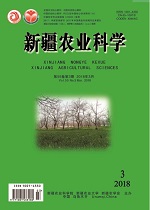|
|
Effects of Potassium Application and Leaf Spraying with Gibberellin on Seed Germination of Spring Wheat
ZHANG Jin-shan, JIA Yong-hong, SUN Peng, LIU Jun, Paridan Maitikuerban, Xieripaimu Aikemu, SHI Shu-bing
2018, 55(8):
1384-1391.
DOI: 10.6048/j.issn.1001-4330.2018.08.002
【Objective】 This project aims to study the effects of gibberellin spraying and foliar application of gibberellin on seed radicle traits, root ability, bud length, transport and consumption of dry matter in spring wheat in order to provide a theoretical basis for exploring the effect of cultivation measures on seed germination of wheat.【Method】 Using wheat Xinchun 31 as the test material, the experimental design of split area was adopted. The main plot was potassium rate (K) at three levels, 0, 180 and 360 kg/hm2, marked K0, K180 and K360, and split block were five gibberellin application rate(G) levels at 0, 8, 16, 24 and 32 g/hm2, marked G1, G2, G3, G4 and G5.【Result】 K application on different germination time of the total root length, root volume, root average diameter, rooting ability, bud length and dry matter of grain transport rate had a significant impact. The total root length, root volume, root and shoot length showed a significant decline with the increase of K application rate, while the root mean diameter was vice versa; Transport rate of dry matter of grain increased first and then decreased with the increase of K application rate; Among them, K180 levels were 26.51% and 38.15% higher than K0 and K360 levels significantly. Leaf spraying with gibberellin had significant effects on root surface area, rooting ability and bud length at different germination times. The root surface area decreased with the increase of gibberellin dosage, but the root force and bud length increased first and then decreased, and reached the maximum at G3 and G2 levels, which were 25.89% and 6.05% higher than those at G0 level, respectively. With the advance of germination time, the total root length increased linearly, the root surface area increased first, and the root volume and mean diameter increased first and then decreased, reaching the maximum on the 4 th day. Transfer rate of dry matter of grain (Y1) and the change of consumption rate (Y2) accord with the quadratic equation, respectively: Y1 = 0.579,7 X2 + 3.682 X + 0.246,6,Y2 = 0.021,5 X2 + 5.082,3 X + 4.064,6.【Conclusion】 Potassium and spraying on the leaf with gibberellin had a significant effect on wheat seed germination, and the optimum potassium rate is 180 kg/hm2, spraying gibberellin on the leaf is 16 g/hm2, which is advantageous to the germination and seedling of wheat seedling.
|

